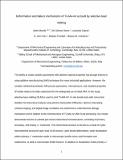Deformation and failure mechanisms of Ti–6Al–4V as built by selective laser melting
Author(s)
Moridi, Atieh; Demir, Ali Gökhan; Caprio, Leonardo; Hart, A John; Previtali, Barbara; Colosimo, Bianca M; ... Show more Show less
DownloadAccepted version (2.528Mb)
Publisher with Creative Commons License
Publisher with Creative Commons License
Creative Commons Attribution
Terms of use
Metadata
Show full item recordAbstract
The ability to create complex geometries with tailored material properties has brought interest in using additive manufacturing (AM) techniques for many industrial applications. However, further understanding of the complex relationship between AM process parameters, microstructure, and resultant properties is critical for the widespread use of metal AM. In this study, selective laser melting (SLM) is used to print Ti–6Al–4V. Tensile tests with concurrent microstructural analysis using electron backscatter diffraction, electron channeling contrast imaging, and digital image correlation are performed to understand the damage and its relation to the microstructure of Ti–6Al–4V after SLM processing. We find that the as-printed Ti–6Al–4V shows hierarchical microstructures, consisting of primary, secondary, and tertiary α martensite. This hierarchical structure is formed as a result of cyclic heat treatment during the layer-wise SLM process. Upon tensile deformation, strain localization within primary α martensite results in microscopic ductile micro-void formation and coalescence, as well as macroscopic brittle fracture. In addition to localization inside primary α , surface steps at the boundaries of these high aspect ratio grains are formed which reveal the contribution of interfacial plasticity to the overall deformation of the material. ' ' '
Date issued
2019Department
Massachusetts Institute of Technology. Department of Mechanical Engineering; Massachusetts Institute of Technology. Laboratory for Manufacturing and ProductivityJournal
Materials Science and Engineering A
Publisher
Elsevier BV